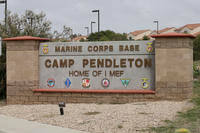As one of the service’s newest ships, Coast Guard Cutter Richard Etheridge has many striking features, but the one feature that stands out the most is the cutter’s nameboard. The polished longleaf heart pine bears the life story of the cutter’s namesake, donated from the structure of the Etheridge family homestead in Manteo, N.C. It also represents the collective efforts of the ship’s sponsor, an Etheridge family member, the cutter’s crew, the cutter project office and the shipyard. Together they fused the legacy of a Coast Guard cutter, a hero and his heritage.
Capt. Richard Etheridge was the first African-American keeper of the Pea Island Life-Saving Station located on the northern half of Hatteras Island off the North Carolina coast where treacherous waters churn in the “Graveyard of the Atlantic.” The six black surfmen who served here under Etheridge often fought unbelievable odds to rescue crews of ships in distress. Despite their challenges, the Pea Island crew had a reputation for being the bravest life-saving crew on the Carolina coast.
“The idea to use any material connected with Richard Etheridge generated over a year in time,” said Cmdr. Christian Lee, commanding officer of the newly commissioned Etheridge. “We wanted to honor the tradition of Richard Etheridge; a tangible reminder of who the cutter was named after.” Retired Coast Guard Rear Adm. Stephen W. Rochon, whose spouse, Shirley, is a sponsor to the cutter, hoped to salvage any material from the original Pea Island Life-Saving Station. Unfortunately, the original structure where Etheridge served no longer exists. Lee and Rochon then turned to John Wilson, Etheridge’s relative and direct descendant of Adam Etheridge, Richard’s grandfather. Wilson is a former mayor of Manteo and is associated with the non-profit that operates “The Island Farm” where the still-standing Etheridge family homestead is located. There was plenty of material there. The longleaf heart pine that originated on Roanoke Island was cut and used in the structure of the Etheridge family home built in 1847. During the restoration at the end of the 20th century, the beam was replaced and it is from that beam the wood was used for the cutter’s nameboard. “We donated the wood to Admiral and Mrs. Rochon [for the cutter] so there could be something from the farm upon which Richard grew up and lived most of his life there until his passing,” said Wilson. “It is a tangible connection to Richard. He likely walked on the floors from which the wood originated.” It was to the advantage of Edgar Watson, a master carpenter in Washington, D.C., that the aged wood was in good condition. Rochon, at his own expense, directed him to remove as much defects and nails and to plane and shape the boards to be later finished by master craftsman Bob Thibodeaux in Lockport, La. Working with the 62-pound and 84-inch unfinished board, Thibodeaux hand carved, stained and varnished the board to etch Richard Etheridge’s name with the unique seal of the U.S. Life-Saving Service, as well as using the surfman insignia unique to the Etheridge era. Presenting the finished nameboard at the cutter’s commissioning was symbolical for the Rochons. It follows the tradition of Capt. Sylvester Gardiner, skipper of the stricken E.S. Newman, who donated the Newman’s nameboard to Richard Etheridge and the Pea Island surfmen for their harrowing rescue of the three-masted schooner in 1896. “When my wife gave the command, ‘Please unveil the nameboard!’ I was full of pride and unable to hold back the tears as the crew undraped the beautiful nameboard adorning the starboard side of the Cutter Etheridge which would remain throughout her service life,” admitted Rochon. “All I could think of at that moment was that I was sure Keeper Richard Etheridge was smiling from heaven at seeing the great honor we bestowed on him with this nameboard on the cutter that now bears his name. In the nameboard, Richard Etheridge’s legacy lives vicariously through the cutter’s mission in lifesaving, in addition to other missions, where Etheridge once dedicated his life’s work.



























